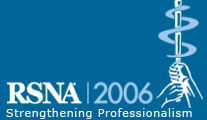
Abstract Archives of the RSNA, 2006
SSE13-03
Hydrodissection as a Technique to Create Access Routes for the Percutaneous Drainage of the "Undrainable" Abscess: Experience with 10 Patients
Scientific Papers
Presented on November 27, 2006
Presented as part of SSE13: Gastrointestinal (Nonvascular Interventional)
Ronald Steven Arellano MD, Presenter: Nothing to Disclose
Debra Ann Gervais MD, Abstract Co-Author: Speakers Bureau, Tyco Healthcare (Valleylab), Boulder,CO
Raul Nirmal Uppot MD, Abstract Co-Author: Nothing to Disclose
Alexander Guimaraes MD,PhD, Abstract Co-Author: Nothing to Disclose
Peter Raff Mueller MD, Abstract Co-Author: Consultant, Cook Group Incorporated, Bloomington, IN
To evaluate the clinical utility, technique, success and complications using image-guided percutaneous hydrodissection to create access routes for percutaneous drainage abdominal abscess surrounded by vital structures.
Patients with abdominal abscesses who otherwise would have required surgical debridement due to lack of access routes for image-guided percutaneous drainage were included in this study. Creation of percutaneous access routes was attempted via image-guided instillation of normal saline to displace vital strucures, thereby creating a path for image-guided percutaneous drainage.
Ten patients with 10 abodminal/pelvic absccess. Image-guided hydrodissection was technically successful in creating access routes in 10/10 abscesses initally deemed undrainable due to overlying vital structures. Volume of injected normal saline ranged from 50-250 cc. No patient in whom percutaneous drainage was achieved after hydrodissection required surgical debridement due to ineffective drainage. There were no complications associated with hydrodissection technique.
Hydrodissection of vital structures is a useful tool to help create access routes for otherwise undrainable abscesses due to overlying vital structures.
Patients with previously considered undrainable abdominal abscesses may be spared the morbidity of surgical debridement if hydrodissection can create a safe acess route for percutaneous drainage.
Arellano, R,
Gervais, D,
Uppot, R,
Guimaraes, A,
Mueller, P,
Hydrodissection as a Technique to Create Access Routes for the Percutaneous Drainage of the "Undrainable" Abscess: Experience with 10 Patients. Radiological Society of North America 2006 Scientific Assembly and Annual Meeting, November 26 - December 1, 2006 ,Chicago IL.
http://archive.rsna.org/2006/4439234.html

